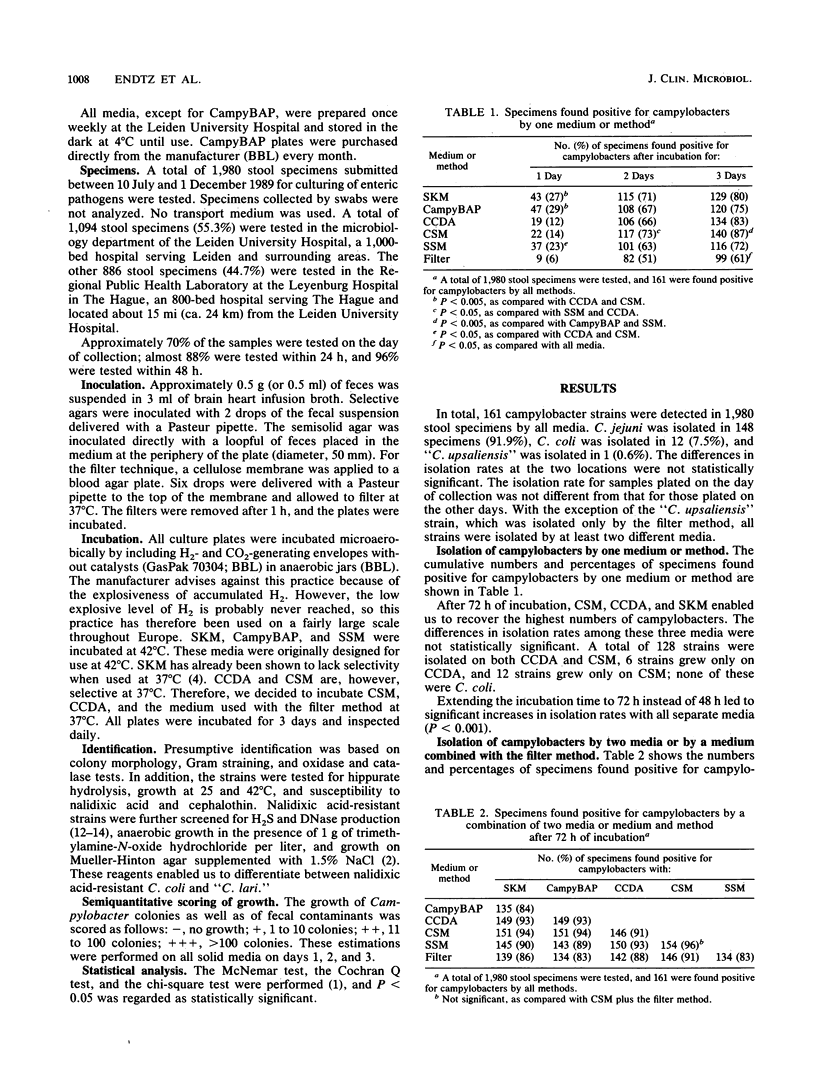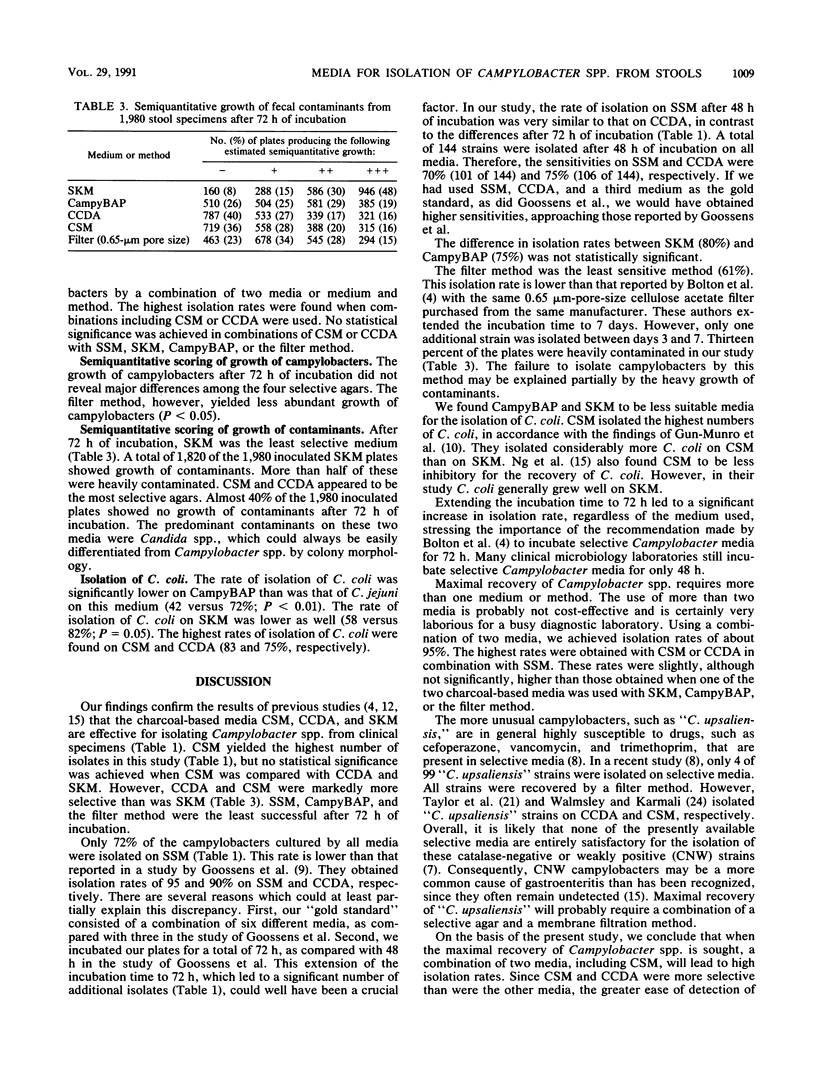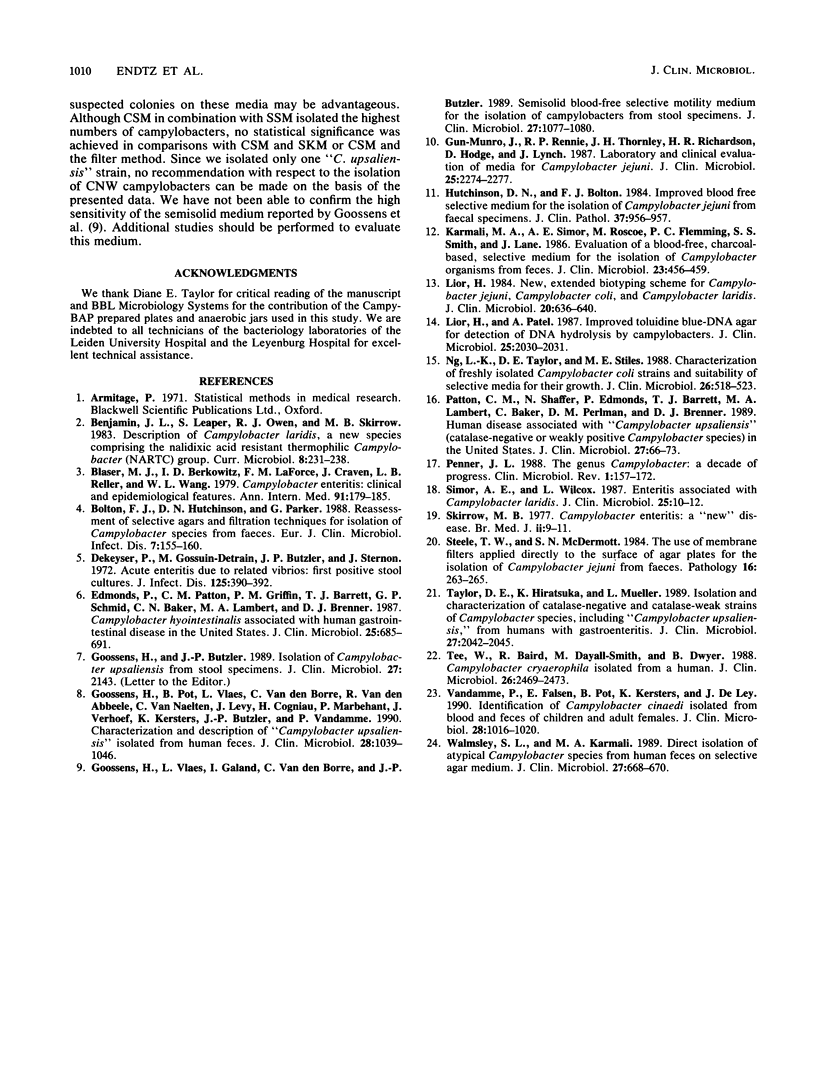Abstract
A recently described semisolid blood-free selective motility medium (SSM) (J. Goossens, L. Vlaes, I. Galand, C. Van den Borre, and J. P. Butzler, J. Clin. Microbiol. 27:1077-1080, 1989) was compared with two charcoal-based selective media (charcoal-based selective medium [CSM] and modified charcoal cefoperazone deoxycholate agar [CCDA]), two blood-based media (Skirrow medium [SKM] and CampyBAP), and a passive, 0.65-microns-pore-size cellulose acetate membrane filter technique for the recovery of campylobacters from stools of patients with diarrhea. A total of 1,980 specimens were tested, 161 of which were found to be positive for campylobacters. Campylobacter jejuni was isolated in 148 specimens (91.9%), C. coli was isolated in 27 (7.5%), and "C. upsaliensis" was isolated in 1 (0.6%). After 72 h of incubation with a single medium, the cumulative percentages of Campylobacter-positive specimens isolated on CSM, CCDA, SKM, and SSM were 87, 83, 80, and 72%, respectively. The filter method alone enabled us to recover 61% of all campylobacters. The "C. upsaliensis" strain was isolated by this method only. The highest isolation rates were observed when two media, including CSM, were combined. The combination of CSM and SSM yielded the highest rates (96%), but these were not statistically different from the rates observed with combinations of CSM and SKM (94%) or of CSM and the filter method (91%). Extending the incubation time from 48 to 72 h led to an increase in the isolation rate regardless of the medium used (P less than 0.001). CSM and CCDA were the most selective media. SKM and CampyBAP appeared to be the most inhibitory media for the isolation of C. coli.
Full text
PDF



Selected References
These references are in PubMed. This may not be the complete list of references from this article.
- Blaser M. J., Berkowitz I. D., LaForce F. M., Cravens J., Reller L. B., Wang W. L. Campylobacter enteritis: clinical and epidemiologic features. Ann Intern Med. 1979 Aug;91(2):179–185. doi: 10.7326/0003-4819-91-2-179. [DOI] [PubMed] [Google Scholar]
- Bolton F. J., Hutchinson D. N., Parker G. Reassessment of selective agars and filtration techniques for isolation of Campylobacter species from faeces. Eur J Clin Microbiol Infect Dis. 1988 Apr;7(2):155–160. doi: 10.1007/BF01963069. [DOI] [PubMed] [Google Scholar]
- Dekeyser P., Gossuin-Detrain M., Butzler J. P., Sternon J. Acute enteritis due to related vibrio: first positive stool cultures. J Infect Dis. 1972 Apr;125(4):390–392. doi: 10.1093/infdis/125.4.390. [DOI] [PubMed] [Google Scholar]
- Edmonds P., Patton C. M., Griffin P. M., Barrett T. J., Schmid G. P., Baker C. N., Lambert M. A., Brenner D. J. Campylobacter hyointestinalis associated with human gastrointestinal disease in the United States. J Clin Microbiol. 1987 Apr;25(4):685–691. doi: 10.1128/jcm.25.4.685-691.1987. [DOI] [PMC free article] [PubMed] [Google Scholar]
- Goossens H., Butzler J. P. Isolation of Campylobacter upsaliensis from stool specimens. J Clin Microbiol. 1989 Sep;27(9):2143–2144. doi: 10.1128/jcm.27.9.2143-2144.1989. [DOI] [PMC free article] [PubMed] [Google Scholar]
- Goossens H., Pot B., Vlaes L., Van den Borre C., Van den Abbeele R., Van Naelten C., Levy J., Cogniau H., Marbehant P., Verhoef J. Characterization and description of "Campylobacter upsaliensis" isolated from human feces. J Clin Microbiol. 1990 May;28(5):1039–1046. doi: 10.1128/jcm.28.5.1039-1046.1990. [DOI] [PMC free article] [PubMed] [Google Scholar]
- Goossens H., Vlaes L., Galand I., Van den Borre C., Butzler J. P. Semisolid blood-free selective-motility medium for the isolation of campylobacters from stool specimens. J Clin Microbiol. 1989 May;27(5):1077–1080. doi: 10.1128/jcm.27.5.1077-1080.1989. [DOI] [PMC free article] [PubMed] [Google Scholar]
- Gun-Munro J., Rennie R. P., Thornley J. H., Richardson H. L., Hodge D., Lynch J. Laboratory and clinical evaluation of isolation media for Campylobacter jejuni. J Clin Microbiol. 1987 Dec;25(12):2274–2277. doi: 10.1128/jcm.25.12.2274-2277.1987. [DOI] [PMC free article] [PubMed] [Google Scholar]
- Hutchinson D. N., Bolton F. J. Improved blood free selective medium for the isolation of campylobacter jejuni from faecal specimens. J Clin Pathol. 1984 Aug;37(8):956–957. doi: 10.1136/jcp.37.8.956-b. [DOI] [PMC free article] [PubMed] [Google Scholar]
- Karmali M. A., Simor A. E., Roscoe M., Fleming P. C., Smith S. S., Lane J. Evaluation of a blood-free, charcoal-based, selective medium for the isolation of Campylobacter organisms from feces. J Clin Microbiol. 1986 Mar;23(3):456–459. doi: 10.1128/jcm.23.3.456-459.1986. [DOI] [PMC free article] [PubMed] [Google Scholar]
- Lior H. New, extended biotyping scheme for Campylobacter jejuni, Campylobacter coli, and "Campylobacter laridis". J Clin Microbiol. 1984 Oct;20(4):636–640. doi: 10.1128/jcm.20.4.636-640.1984. [DOI] [PMC free article] [PubMed] [Google Scholar]
- Lior H., Patel A. Improved toluidine blue-DNA agar for detection of DNA hydrolysis by campylobacters. J Clin Microbiol. 1987 Oct;25(10):2030–2031. doi: 10.1128/jcm.25.10.2030-2031.1987. [DOI] [PMC free article] [PubMed] [Google Scholar]
- Ng L. K., Taylor D. E., Stiles M. E. Characterization of freshly isolated Campylobacter coli strains and suitability of selective media for their growth. J Clin Microbiol. 1988 Mar;26(3):518–523. doi: 10.1128/jcm.26.3.518-523.1988. [DOI] [PMC free article] [PubMed] [Google Scholar]
- Patton C. M., Shaffer N., Edmonds P., Barrett T. J., Lambert M. A., Baker C., Perlman D. M., Brenner D. J. Human disease associated with "Campylobacter upsaliensis" (catalase-negative or weakly positive Campylobacter species) in the United States. J Clin Microbiol. 1989 Jan;27(1):66–73. doi: 10.1128/jcm.27.1.66-73.1989. [DOI] [PMC free article] [PubMed] [Google Scholar]
- Penner J. L. The genus Campylobacter: a decade of progress. Clin Microbiol Rev. 1988 Apr;1(2):157–172. doi: 10.1128/cmr.1.2.157. [DOI] [PMC free article] [PubMed] [Google Scholar]
- Simor A. E., Wilcox L. Enteritis associated with Campylobacter laridis. J Clin Microbiol. 1987 Jan;25(1):10–12. doi: 10.1128/jcm.25.1.10-12.1987. [DOI] [PMC free article] [PubMed] [Google Scholar]
- Skirrow M. B. Campylobacter enteritis: a "new" disease. Br Med J. 1977 Jul 2;2(6078):9–11. doi: 10.1136/bmj.2.6078.9. [DOI] [PMC free article] [PubMed] [Google Scholar]
- Steele T. W., McDermott S. N. The use of membrane filters applied directly to the surface of agar plates for the isolation of Campylobacter jejuni from feces. Pathology. 1984 Jul;16(3):263–265. doi: 10.3109/00313028409068535. [DOI] [PubMed] [Google Scholar]
- Taylor D. E., Hiratsuka K., Mueller L. Isolation and characterization of catalase-negative and catalase-weak strains of Campylobacter species, including "Campylobacter upsaliensis," from humans with gastroenteritis. J Clin Microbiol. 1989 Sep;27(9):2042–2045. doi: 10.1128/jcm.27.9.2042-2045.1989. [DOI] [PMC free article] [PubMed] [Google Scholar]
- Tee W., Baird R., Dyall-Smith M., Dwyer B. Campylobacter cryaerophila isolated from a human. J Clin Microbiol. 1988 Dec;26(12):2469–2473. doi: 10.1128/jcm.26.12.2469-2473.1988. [DOI] [PMC free article] [PubMed] [Google Scholar]
- Vandamme P., Falsen E., Pot B., Kersters K., De Ley J. Identification of Campylobacter cinaedi isolated from blood and feces of children and adult females. J Clin Microbiol. 1990 May;28(5):1016–1020. doi: 10.1128/jcm.28.5.1016-1020.1990. [DOI] [PMC free article] [PubMed] [Google Scholar]
- Walmsley S. L., Karmali M. A. Direct isolation of atypical thermophilic Campylobacter species from human feces on selective agar medium. J Clin Microbiol. 1989 Apr;27(4):668–670. doi: 10.1128/jcm.27.4.668-670.1989. [DOI] [PMC free article] [PubMed] [Google Scholar]


